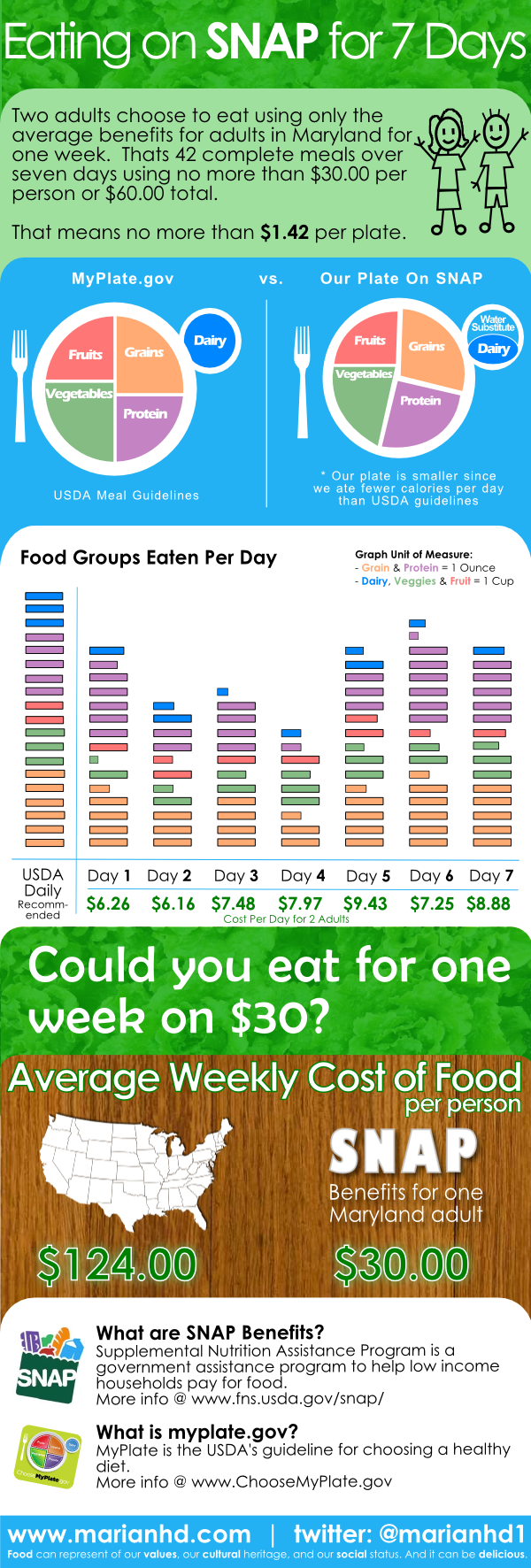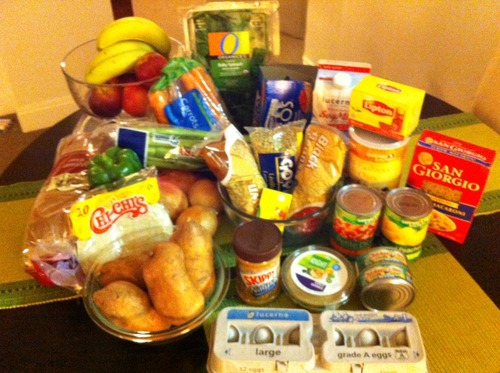Guest blog post from Marian Dickinson, a graduate student at the Johns Hopkins School of Public Health. She was a student in UVM’s 2012 Breakthrough Leaders Program for Sustainable Food Systems. She blogs at For the Love of Food.
I convinced my husband to do something a little strange with me for a week. We only ate what we could purchase for $60–the average SNAP benefits for two people here in Maryland. It’s a challenge promoted by Maryland Hunger Solutions to encourage policymakers like Mayors, journalists, and average folks like myself to see what it’s really like to try to eat enough food and healthy food for a week on food stamps.
For three days, I brainstormed a menu for the week, searching recipe sites for simple lentil soup and cost-effective pasta. Two days before we started, my husband and I went to the grocery store armed with my Excel spreadsheet of meals for the week, a shopping list, a list of coupons downloaded to my loyalty card, and an iPad to serve as the high-tech calculator to keep us on track. And here’s what we brought home with us:
As we ate our way through all this food, we learned 5 big lessons.
1. Eating healthy on a budget is hard.
We are both typically healthy eaters. We like our fruits and vegetables, we like our grains whole and our food minimally processed. I already cooked from scratch most days. But I wasn’t accustomed to using quite so much pasta, rice, bread, and peanut butter. We went through an entire jar of peanut butter in a week! Our fruit and vegetable consumption was overshadowed slightly by our carbohydrate consumption for the purpose of saving money. Eating more fruits and vegetables would have meant eating less food, and that’s a scary premise when money is tight.
2. Making cheap food delicious and interesting takes time, skill, and creativity.
I came into this challenge with a few advantages. I have been baking and cooking for nearly 20 years, I like to cook, I only work one job, and it’s just the two of us and we aren’t picky eaters. Planning the menus and shopping for this week took significantly longer than a typical week. That was time I could afford, and I enjoyed the challenge of the task. But not everyone has extra time, a love of cooking, or the luxury of only pleasing two palates. And although I’m proud that we took the challenge and managed to purchase groceries within our $60 budget, I have no intention of making this a long-term deal.
3. Hunger makes everything else harder.
Day 3 made this ultimately clear. Just spending a day walking around Annapolis and visiting the Naval Academy was more challenging when hungry. We got cranky and tired and just wanted to go home early instead of taking a boat tour like we had originally hoped. Normally, we could have just stopped and picked up a snack, or I would have brought granola bars to ward off hunger instantly. Instead we had to go back to our car to get our carrots and hummus out of the cooler and inhale them before driving home.
4. Feeling limited in food choices ruins good judgment.
This might sound harsh, but let me explain. My husband and I are typically very selective about what we eat. We prefer foods that we know will help us feel healthy. But in the grocery store and in situations of free or cheap food, our standards dropped. I would usually prefer whole wheat pasta, but for $.67 I’d take regular pasta on our SNAP budget. At the farmers’ market, my husband was not strong enough to resist a blueberry and cheese Danish when he heard them discounted to $1 at the end of the market day. On the first day after the challenge he also couldn’t resist a couple slices of bad pizza simply because he was now “allowed” to purchase it. Selectiveness is a luxury for those who have many options.
5. Feeling satisfied and feeling full are two different feelings. I certainly felt hunger during my week challenge, which wasn’t something I was accustomed to. But I was always able to satisfy my hunger, even if it wasn’t with the most interesting meals. In the portioning of food that was necessary to make $60 last a week for two people, we weren’t able to eat until we were full, at least not until the last day when we knew we could eat whatever was left. At the end of each meal however, my husband and I both agreed that we felt satisfied and no longer hungry.
Here’s a snapshot how we did financially and nutritionally.
 To learn more about the challenge, find some of the recipes I used for the week, and hear some of my husband’s thoughts, visit www.marianhd.com.
To learn more about the challenge, find some of the recipes I used for the week, and hear some of my husband’s thoughts, visit www.marianhd.com.












